These Will Be the Biggest Facial Plastic Surgery Trends for 2025
2025 is set to bring a new era of facial plastic surgery procedures and personalized treatments. Renowned facial plastic surgeon Philip J. Miller, MD, FACS, is excited to share insights into the latest trends shaping the field, emphasizing natural aesthetics, technological advancements, and customized approaches. Here’s a glimpse into what top facial plastic surgeons like Dr. Miller foresee as the defining trends for the coming year.
1. The Rise of Customized Facial Implants
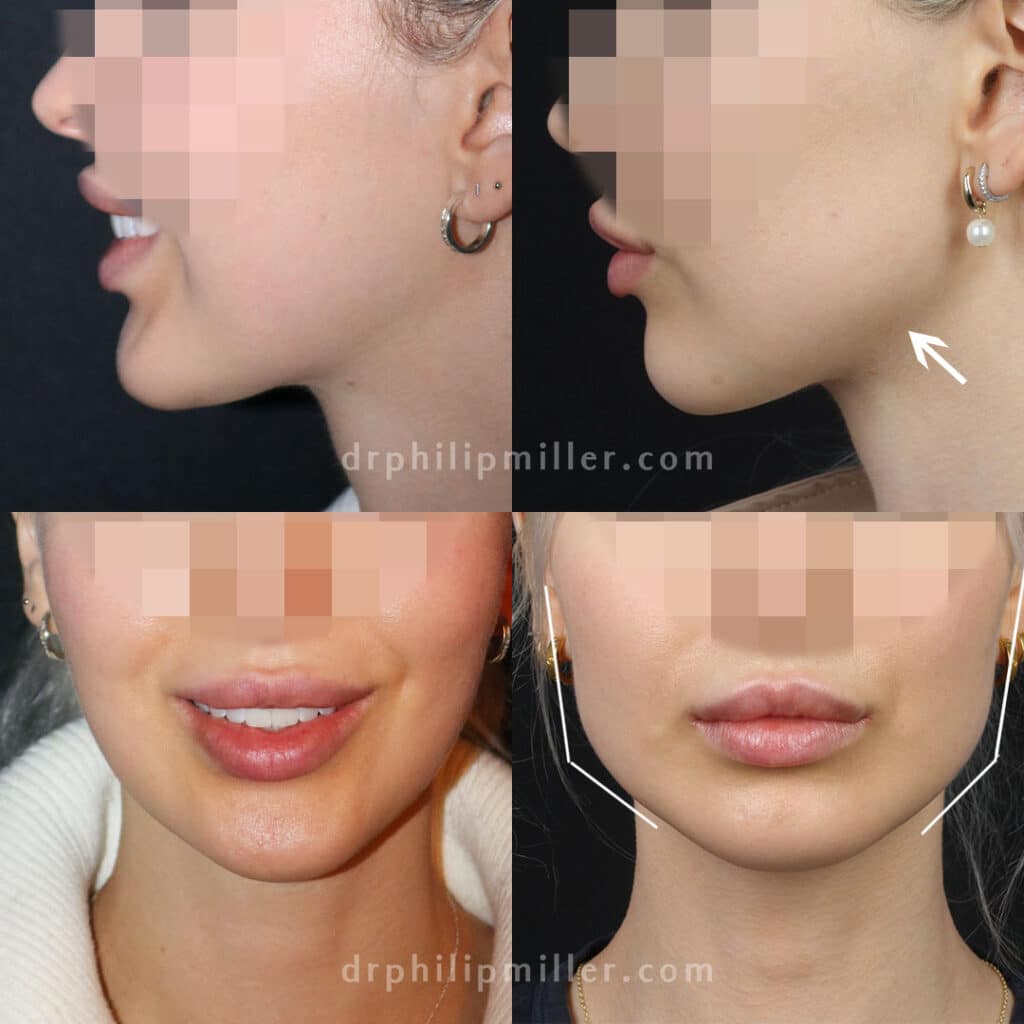
Customization is key in modern facial plastic surgery, and nowhere is this more evident than in using facial implants. Customized implants, tailored to each individual’s unique facial structure, offer unparalleled precision in enhancing and balancing facial features.
Whether it’s augmenting the chin, cheeks, or jawline, these implants provide a permanent, harmonious solution that complements a patient’s inherent beauty.
2. Embracing Natural Aesthetics
Modern facial plastic surgery is less about transformation and more about refinement. Patients now seek results that enhance their natural features rather than overhaul them. This shift toward subtle, understated changes aligns perfectly with our philosophy, which aims to achieve elegance and balance while respecting the patient’s originality. Procedures like mini facelifts, facial liposuction, and buccal fat removal aim to rejuvenate one’s appearance while respecting their unique features.
3. Profile Perfection with Chin Augmentation

In a world where personal image is paramount, achieving a balanced facial profile has become a significant focus. Chin augmentation, through personalized implants, fillers, or fat grafting, is increasingly popular for creating a complementary facial silhouette. Our clinic specializes in customizing these procedures to enhance the individual’s natural profile, boosting confidence and self-esteem.
4. Eyelid and Brow Lifts as Long-Lasting Solutions
With the limitations of non-surgical treatments like Botox® becoming more apparent, patients are increasingly opting for more permanent solutions. Eyelid lifts (blepharoplasty) and brow lifts offer a lasting way to address aging signs around the eyes and forehead, providing a rejuvenated appearance while preserving the face’s natural contours.
5. The Micro Lift Technique
Innovations in facelift techniques are now catering to younger demographics seeking subtle enhancements. The micro lift is gaining popularity for its ability to create a naturally youthful look with minimal scarring and downtime.
6. The Growing Demand for Neck Lifts

Neck lifts are becoming a staple in facial rejuvenation, addressing issues like sagging skin and muscle banding in the neck region. By tightening the underlying muscles and removing excess skin, a neck lift can significantly enhance one’s profile and provide a more youthful neck contour. This procedure often complements facelifts, ensuring a seamless and comprehensive rejuvenation.
Schedule a Facial Plastic Surgery Consultation in NYC
These 2025 trends reflect a broader movement towards personalized, natural-looking results in facial plastic surgery. From customized implants to advanced skin treatments and innovative lifting techniques, the focus is on enhancing individual beauty while ensuring patient safety and satisfaction. At our clinic, we’re committed to staying at the forefront of these developments, offering our patients the best in facial plastic surgery. Contact Dr. Miller in his Manhattan, New York, or New Orleans, Louisiana office to schedule a consultation.
Surgical or Liquid (Non-Surgical) Rhinoplasty: Which one is right for me?
When it comes to getting a nose job, there are two basic options: surgical or non-surgical. Surgical rhinoplasty requires anesthesia, incisions, and downtime, but produces permanent improvement. A non-surgical rhinoplasty, commonly known as a liquid rhinoplasty, is a less invasive option that utilizes injectable fillers to temporarily change the appearance of the nose.
When considering a rhinoplasty, it is essential to realize that different types of rhinoplasty procedures are used, depending on the severity of alterations. Individualizing a rhinoplasty procedure ensures that results are natural and balanced to your unique facial features.
What is liquid rhinoplasty?
Liquid rhinoplasty is a non-surgical alternative to a surgical rhinoplasty procedure that uses injectable dermal fillers to make the nose more appealing. This less invasive option may produce pleasing results with a quicker approach and less recovery time.
Juvederm® and Restylane® are two common dermal fillers used for liquid rhinoplasty. Juvederm is an FDA-approved volume enhancer containing hyaluronic acid, a naturally occurring substance in the body. Restylane is another hyaluronic acid injectable that restores and rejuvenates the skin. These fillers can add hydration and volume to the nose and alter the shape for a more appealing appearance.
Even though liquid rhinoplasty is not a surgical procedure, it still requires skill and experience to inject the filler into the correct area for intended results. The process is quick and patients can return to normal daily activities after the injection. It is an effective alternative with many benefits, including:
- Non-invasive
- Minimal downtime
- Safe and effective
- Instant results
- Smoother nose shape
- More balanced appearance
What’s the difference between liquid and regular rhinoplasty?
Surgical and liquid rhinoplasty are two very different procedures with different processes, results, recovery, costs, and expectations. Take a look at the breakdown:
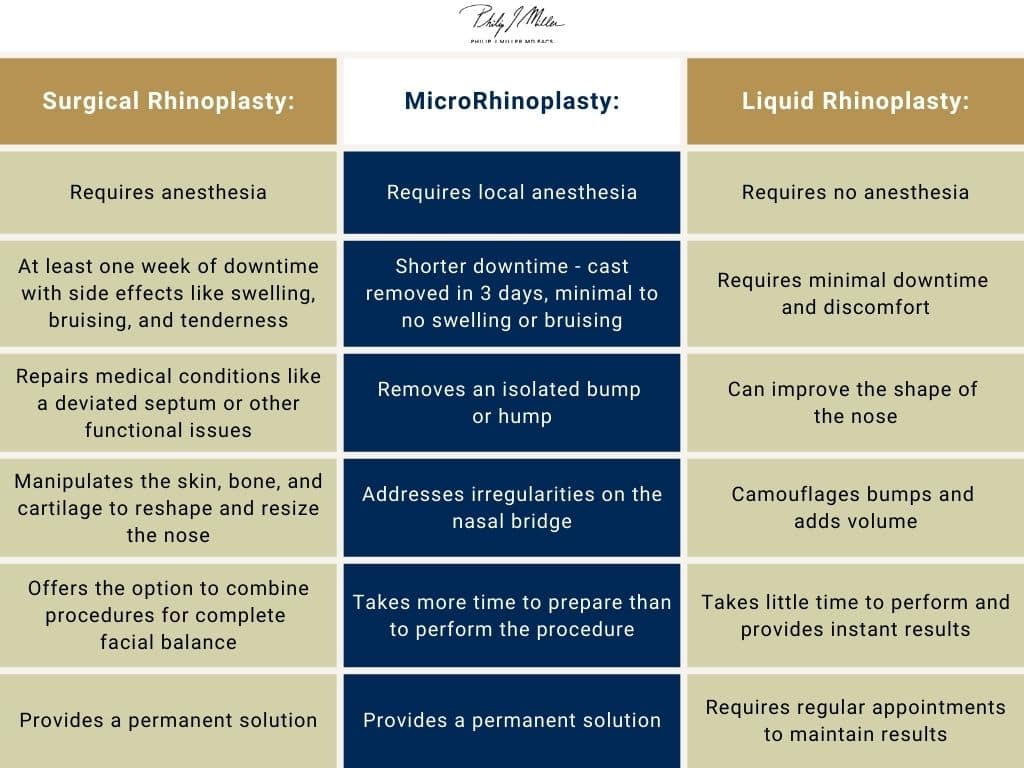
Surgical Rhinoplasty:
- Requires anesthesia
- Manipulates the skin, bone, and cartilage to reshape and resize the nose
- Repairs medical conditions like a deviated septum or other functional issues
- Requires downtime of at least one week before returning to work and daily activities
- Is associated with side effects like swelling, bruising, and tenderness
- Provides a permanent solution
- Offers the option to combine procedures for complete facial balance
Liquid Rhinoplasty:
- Is minimally invasive
- Requires minimal downtime and discomfort
- Can improve the shape of the nose
- Camouflages bumps and adds volume
- Takes little time to perform
- Provides instant results
- Is associated with minimal swelling, bruising, and tenderness
- Requires regular appointments to maintain results
How much does liquid rhinoplasty cost in NYC?
The cost of rhinoplasty procedures varies by patient and depends on the treatment plan. Non-surgical rhinoplasty costs typically range from $300-$1300 per treatment. Some of the factors that impact price include:
- Type of dermal fillers used
- Number and amount of filler injected
- Experience and expertise of injector
It is also important to understand that liquid rhinoplasty is not a permanent solution and requires regular appointments to maintain the desired shape. Patients can learn more about the specific costs of liquid rhinoplasty during a consultation with Dr. Miller.
@drphilipjmiller #liquidrhinoplasty ! In 10 minutes, no down time, you will have a new nose that last about 2 years. Call today and book a session with me! #nonsurgicalrhinoplasty ♬ original sound – Sam Smith
How much does surgical rhinoplasty cost in NYC?
Surgical rhinoplasty encompasses a wide range of possible alterations and additional steps, such as a graft or implant. Due to the variance in procedure possibilities, there is also a wide range of costs. An average surgical rhinoplasty procedure in New York City ranges from $3,500-$25,000. During a consultation, Dr. Miller will explain the treatment plan and expected costs.
How long does liquid rhinoplasty last?
Unlike a surgical rhinoplasty, liquid rhinoplasty is not a permanent solution. This treatment requires regular appointments to maintain your pleasing results. Results vary by patient depending on how many dermal fillers were used, where they were injected, and the level of correction required. Many patients see results for around 18 months before needing a touch-up session. Dr. Miller and his expert team will evaluate your nose and treatment plan for a suggested maintenance schedule to keep a natural and well-balanced nose shape.
How long does surgical rhinoplasty last?
Surgical rhinoplasty is a permanent procedure that has lifelong results. Once the nose is reshaped and altered, it will remain in its new state with proper care.
Which one is better: surgical or non-surgical rhinoplasty?
Both procedures are practical and effective solutions, depending on the patient’s specific needs and desires. Philip Miller, MD, FACS, strives to help patients achieve aesthetic confidence and natural results using the NatraLook® process. During your consultation, Dr. Miller discusses your concerns and expectations to identify which procedure is right for you and create a unified treatment plan.
Dr. Miller is a double board-certified surgeon in facial plastic and reconstructive surgery and head and neck surgery. He is a world-class surgeon and leading expert in rhinoplasty and facial rejuvenation. With more than 20 years of expertise, Dr. Miller works closely with patients to identify their needs and desires to create unmatched results.
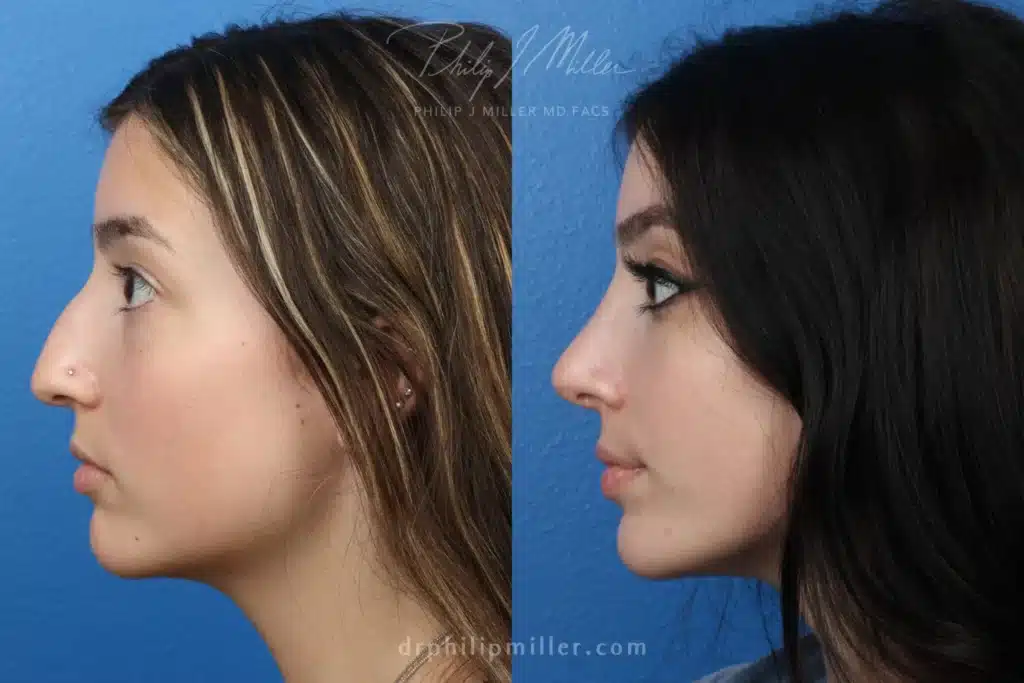
Contact us to schedule a consultation and learn more about which rhinoplasty procedure is right for you.
What Age is Normal to Get Wrinkles?
There really is no “normal” age when we start to notice wrinkles. Their formation depends on a variety of factors – some of which we can control and others we can’t. While your friend might start to notice fine lines around the eyes in her 20s, you might not see lines develop until almost a decade later.
Wrinkles are a normal part of aging. Some wrinkles are the result of repeated facial expressions like squinting or smiling. Others occur because of collagen depletion in the dermal structure, which leads to skin laxity and facial creasing. Factors that might accelerate this process include genetics, sun damage, poor diet, and lifestyle choices like smoking and drinking alcohol.
What age do wrinkles start appearing?
The aging process is different for each patient. Many people show the first signs of aging in their mid-20s as our bodies begin to produce less collagen and sun damage can take an early toll. Prominent signs of aging like wrinkles often appear on the face, neck, hands, and forearms, with the most noticeable areas on the neck and face. While aging cannot be stopped, there are many ways to promote healthy skin and reduce wrinkles, sun damage, sagging skin, and other signs of aging.

Are wrinkles normal at 20?
As individuals move out of their teens and into their 20s, signs of aging can begin to appear. The first signs of wrinkles in your 20s are movement lines around the brow, mouth, and eyes, due to repetitive movements like smiling, laughing, and frowning. Significant wrinkles and lines on the forehead and other areas are not typical. If they do occur this early, they can likely be attributed to factors like excessive sun damage or lifestyle choices like smoking.
Are wrinkles normal at 30?
Most people still have a youthful appearance in their 30s without significant wrinkles. Wrinkles and fine lines may become more apparent in the mid-to-late 30s, or even sooner depending on sun exposure and other variables. The most common spots for lines at this age are between the eyebrows (frown lines) and the triangle areas between the nose and corners of the mouth (nasolabial folds).
What causes wrinkles?
Wrinkles are just one of the many changes to our skin as we age. As we grow older, our skin loses elasticity and becomes thinner and more translucent. Aging skin is more fragile and retains less moisture, making it easier for wrinkles to form. While age is a major contributing factor to wrinkles, there are many causes, including:
- Repetitive facial movements
- Sun damage
- Smoking and alcohol consumption
- Lack of proper skin care
- Dehydration
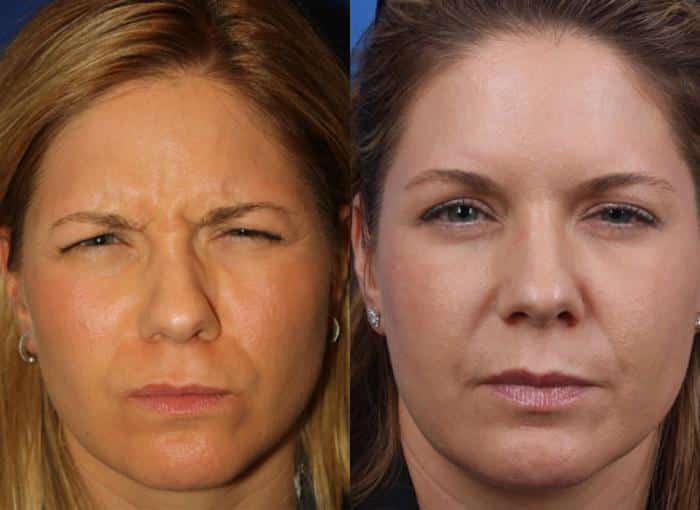
Wrinkle Prevention
Aging is an inevitable process, but there are many preventative measures that can keep skin looking young, healthy, and wrinkle-free, including:
- Sun Protection: Sun exposure is the leading cause of premature aging and can be prevented with proper protection like hats, sunglasses, and sunscreen. Sun protection should be worn every day to avoid damaging ultraviolet rays from penetrating your skin, even if it is overcast.
- Moisture: A quality moisturizer helps nourish and hydrate the skin, especially ones containing hyaluronic acid. Dry skin is more prone to wrinkles, and daily moisturizers can prevent wrinkles.
- Water: Drinking enough water each day is essential for overall health and skin health. Water can help flush toxins, regulate digestion, and keep your skin hydrated from the inside out to promote a youthful appearance.
- Diet and Exercise: Eating vitamin-rich foods like salmon, avocados, vegetables, and leafy greens are key to absorbing nutrients and antioxidants that promote healthy skin cells. Exercise increases blood flow to the dermal tissue, helping you maintain a rosy glow and keeping skin in top condition.
Wrinkle Treatment
Wrinkles are inevitable at some point, despite our best efforts. There are treatments to help reduce those lines and promote a youthful appearance, from minimally-invasive dermal fillers to facelift surgery. Gotham Plastic Surgery in New York offers:
- Dermabrasion: A skin resurfacing procedure that removes the top layer of skin for rejuvenation and reduction in wrinkles and other signs of aging.
- Botox®: This injectable treatment effectively reduces facial lines like crow’s feet, frown lines, worry lines, forehead lines, and neck wrinkles.
- Liquid facelift: A non-surgical treatment that combines facial fillers like Restylane and Juvederm to reduce wrinkles and add volume.
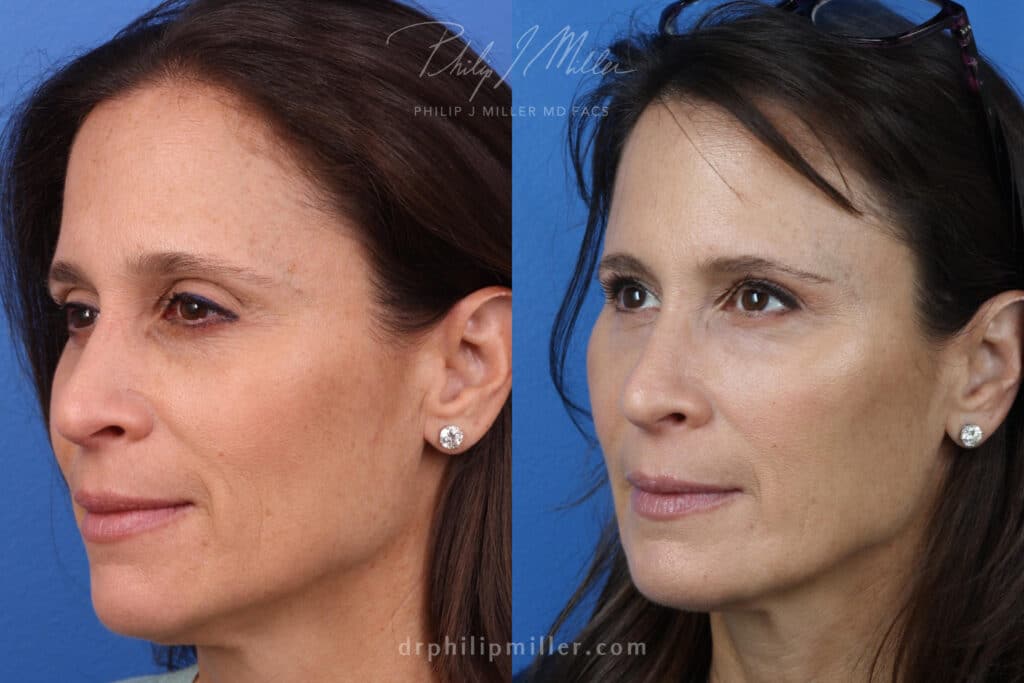
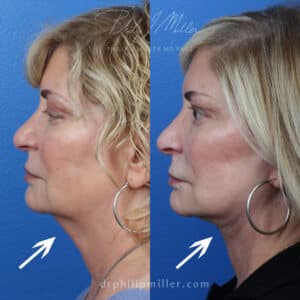
- FaceTite: This non-surgical treatment delivers radiofrequency energy into the dermal tissue to tighten skin and boost collagen levels for a reduction in visible wrinkles.
- MicroLift: This less invasive surgical facelift technique resembles the result you get when you pull up your hair in a tight ponytail. With smaller incisions and a shorter recovery time, it can be a good option for younger patients before they opt for a deep plane facelift.
- Deep plane facelift and neck lift: These surgical procedures remove and tighten skin, while repositioning fat and tissue to reduce sagging and wrinkles.
Schedule Your Wrinkle Treatment at our Manhattan Office
Gotham Plastic Surgery is an innovative practice that serves patients in a discreet, confidential, and accredited facility. Led by Dr. Philip Miller, a double board-certified facial plastic surgeon, our team works closely with patients to identify the best wrinkle treatment plans to help patients look younger, healthier, and more natural.
Dr. Miller uses the NatraLook® process to empower patients to explore their aesthetic confidence and naturally enhance their appearance. Gotham Plastic Surgery in New York is a safe and positive environment to discuss personal desires and achieve beauty goals through a unified vision.
Contact us to schedule a consultation and learn more about our wrinkle treatments.
Next, read about your options with Three Types of Facelifts.
How to Reduce Swelling after Lip Fillers
Swelling after lip fillers is a common concern, but the good news is there are simple ways to reduce swelling, like cool compresses and elevation. When you know how to treat this side effect, you can go into your lip filler treatments with less anxiety and more confidence.
Lip shape and size are important measures of beauty and age. Typically, small, thin lips are not considered beautiful and can appear disproportionate and unbalanced with other facial features. Lip fillers have been around for decades and are popular for several reasons. Lip fillers add a smoother, more natural-looking appearance to the lips and enhance the natural shape for fuller lips.
While lip fillers are a great way to enhance your lips, they can also cause swelling, which may result in a puffy appearance after treatment.
Why does swelling occur with lip fillers?
Fillers are a great way to achieve the shape that you want your lips to have. A lip filler is a gel-like substance placed into the lips with a small needle or tiny tube called a microcannula. These dermal fillers offer immediate changes to the lips, making them a very satisfying treatment option.
If you are worried about swelling and bruising after lip fillers, it is important to know it is temporary. Swelling is caused by the process of placing the filler into the lip area; even a tiny puncture can cause minor swelling. The lips are a sensitive area, and the injection can cause slight trauma to the tissue – swelling above the lip after lip fillers is the natural response to that trauma.
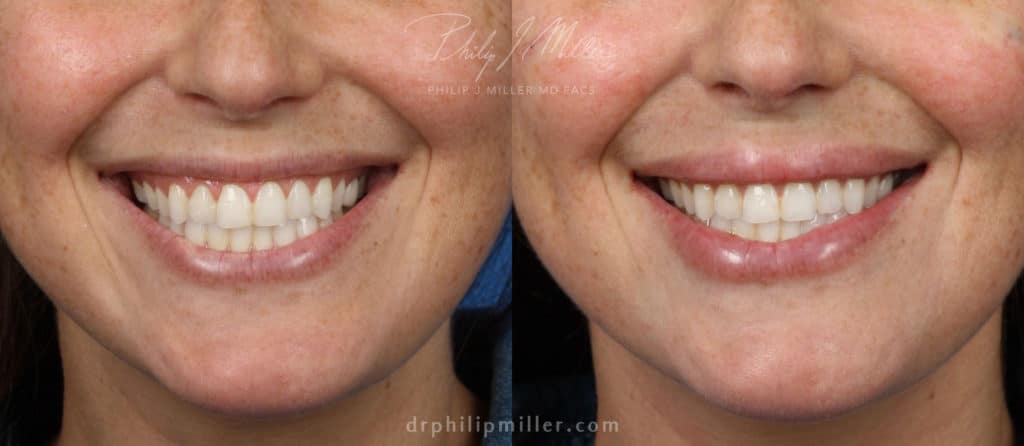
How much swelling is normal after lip fillers?
Swelling varies by patient and can depend on factors like how many injections were used, if it was a combination treatment, and natural bodily responses based on sensitivity. Swelling is typically minimal and may make the lips appear puffy or lumpy. Swelling should begin to subside after 3-4 days although it can last up to two weeks in rare instances.
Some patients consider a fair amount of swelling after injection but notice an improvement by the fourth day. If you are concerned with how much swelling is normal after lip fillers, it is a good idea to contact your injector with your questions.
When does swelling go down after lip fillers?
The amount of filler used during treatment can impact swelling and the expected recovery timeline. By the third day, most of the swelling should be gone, allowing you to really see your treatment results. Any discomfort or tenderness in the injection site should also go away by the fourth day, and the results should be noticeable. A few patients might have minor swelling for up to two weeks and should wait until this point for complete injection results.

How to Decrease Swelling After Lip Fillers
There are simple ways to reduce swelling after your lip filler treatment to relieve discomfort and enjoy the results sooner. Patients can:
- Apply a cold compress around the area, but not directly on the lips
- Relax and avoid repetitive or harsh contact with the mouth and lips
- Drink lots of water to keep the tissue hydrated
- Apply aloe vera or a recommended cream to the lips for hydration and healing
- Sleep with your head elevated
How to Prevent Swelling After Lip Fillers
Different lip fillers can have different results and side effects. It is important to consult with your injector about what to expect before, during, and after your treatment. For many fillers, swelling can be prevented by following aftercare instructions and avoiding certain activities. You can prevent swelling after lip filler by avoiding:
- Kissing or using a straw for drinking for two-three days
- Eating sodium-rich foods
- Using makeup or lipstick for one-two days after treatment
- Engaging in strenuous activity
- Consuming alcohol
- Taking blood thinners like ibuprofen or aspirin
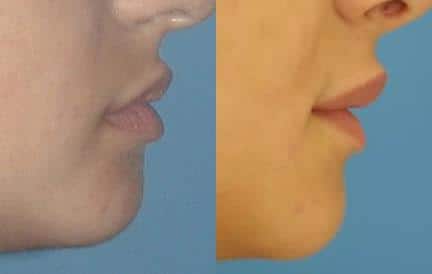
Schedule Your Lip Plumping Treatment at Our Manhattan Office Today
Gotham Plastic Surgery provides comprehensive treatment plans to help patients achieve natural, youthful, and stunning results. The experience and expertise of Dr. Phillip Miller, a double board-certified facial plastic surgeon, allows patients to explore and experience the best version of themselves, including fuller lips.
Lips are a delicate and prominent feature that requires skill and experience to develop desirable shape and fullness. Too much injection can cause overly inflated, unnatural-looking lips, and too little can lead to underwhelming results.
Dr. Miller uses the NatraLook® process to help patients achieve exceptional and natural results. This approach to plastic surgery creates a safe and supportive environment for patients to explore their aesthetic confidence and naturally enhance their appearance.
Contact us to schedule a consultation and learn more about our lip augmentation treatments.
What To Do After Rhinoplasty
Finding a skilled and reputable surgeon to perform your rhinoplasty is only half the battle won. Taking the proper precautions to heal is equally important to ensure an optimal outcome.
Philip J. Miller, MD, FACS, is a double board-certified facial plastic surgeon in Manhattan, New York and New Orleans, Louisiana. He is considered a highly skilled facial plastic surgeon with expertise in rhinoplasty. Through decades of working with his patients, Dr. Miller knows that educating his patients is a critical step in ensuring the best possible results for them.
Dr. Miller offers a proprietary consultation process called NatraLook which expands the typical plastic surgery experience into a safe, collaborative environment where you can explore your aesthetic confidence. This opportunity allows you and Dr. Miller to create a unified vision for your results and the safest, most natural outcome possible.
Rhinoplasty is an extensive surgical procedure that requires downtime afterward to ensure the nose heals properly. Preparation for the procedure and subsequent recovery will help ensure a smoother healing process. We have a list of some of the most common questions Dr. Miller gets asked about recovery from rhinoplasty to help you begin your preparation for your own procedure.
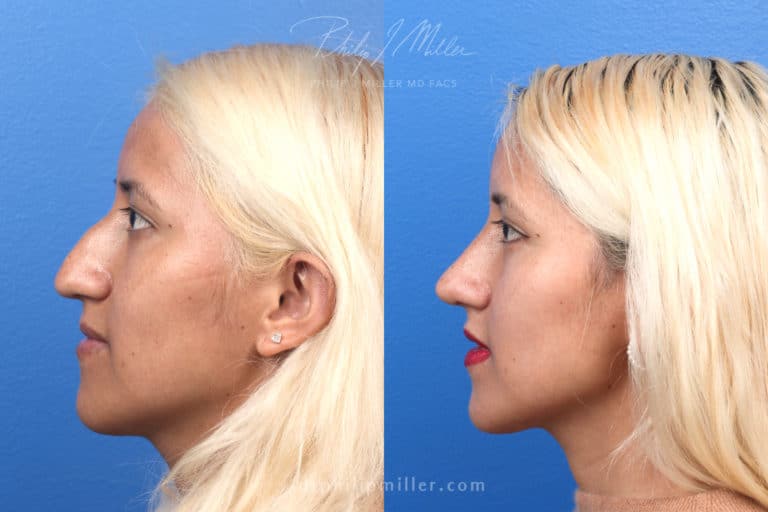
How to clean my nose after rhinoplasty?
Recovery is more than just taking it easy for a few weeks and just resting at home. You will also need to take care of your nose while it heals by keeping it clean and clear. This will not only aid in proper healing, but will help you feel more comfortable too.
Cleaning should only be done after any packing has been removed from your nose. You may use a Q-tip and hydrogen peroxide to gently clean and disinfect your nose. To remove dried blood and mucus out of the nasal passages, you may use a saline spray to irrigate your nose, clear drainage, and keep it moist. The saline may also help reduce swelling in the area.
When can I wash my face after rhinoplasty?
Washing the face is another step that will help you feel better as you go through your rhinoplasty recovery. Once the tape, splint, or cast is removed, you can wash your face with water and a gentle facial cleanser. Avoid rubbing your face around the nose – instead, pat dry carefully so you don’t disturb the treatment area.
What can I eat after rhinoplasty?
Rhinoplasty surgery shouldn’t restrict your diet significantly, but there are general guidelines after your procedure:
- Eat soft, easy-to-digest foods like oatmeal, mashed potatoes, yogurt, scrambled eggs, and soup (not too hot) for the first few days.
- Avoid hard or crunchy food items like apples and carrots that can increase facial movement, or foods like burgers and large sandwiches that require you to open your mouth wide. The idea is to put as little strain on the nasal structure and surrounding tissue as possible.
- Avoid salty foods which will increase fluid retention in your body and can lead to more swelling.
- Eat healthy foods like fruits, vegetables, and proteins that will promote wound healing (e.g., berries, leafy greens, beans, nuts and seeds, and poultry).
- Drink plenty of fluids to keep yourself sufficiently hydrated.
How to massage nose after rhinoplasty
Dr. Miller may prescribe gentle nasal massage on the bridge, middle, or tip of the nose to help soften scar tissue, reduce swelling, and promote healing. Always check with your surgeon before performing any physical therapy or massage after your surgery. In general, the pressure of the massage should be firm enough to smooth the swelling caused by fluids but not so hard that it causes pain, bruising, or deformity to your delicate tissues.
As a general rule, avoid placing any pressure on one part of the nose that causes significant movement in other areas of the nose. You must use your fingers to support the nose to prevent excessive movement during the massage. We will instruct you on how to massage your nose if this is a step we recommend for you during recovery.
How should I sleep after rhinoplasty?
Your nose will be delicate and malleable after surgery, so it is crucial that you do not sleep on your stomach or side for several weeks. These positions can put unnecessary pressure on your nose, cause discomfort, and also compromise your results. Sleeping on your back, elevated with a few pillows, is the best sleeping position for your first week or two of recovery. This position will minimize fluid buildup and congestion. It is also best to sleep alone to avoid any accidental elbow to the face that may impact your rhinoplasty results.
Experiencing slight disturbances in your sleep patterns is normal. Dr. Miller may prescribe a light sleeping aid or pain medication to help you through the first few nights.
Why Dr. Miller is a Top Choice for Rhinoplasty in New York
The best way to ensure a positive recovery after a nose job is to follow all of Dr. Miller’s instructions, go into your procedure with realistic expectations and come to all your follow-up appointments.
To schedule a consultation with Dr. Miller, contact our New York City plastic surgery clinic today.
Rhinoplasty Swelling Stages: What to Expect
Rhinoplasty is major surgery that will require significant downtime. Although the majority of the healing process will take place within the first few days and weeks, small amounts of swelling may continue to persist for up to one year. Every nose job is different, and every patient will heal at their own pace.
The best way you can ensure a good recovery after a nose job with Dr. Miller is to carefully follow all of his pre- and post-op instructions. As a double-board certified facial plastic surgeon and expert in rhinoplasty, Dr. Miller has performed thousands of rhinoplasty procedures. He has developed a surgical plan to keep swelling to a minimum and produce the best possible results for his patients.
Rhinoplasty recovery will depend on several factors, including the patient’s skin texture and the surgical technique used. Revision procedures tend to have a longer recovery than the initial surgery. No matter what your surgery looks like, swelling is to be expected, and the recovery process will typically follow the same basic structure.
What to Expect 1 Week Post-Rhinoplasty
You will want to give yourself plenty of time for rest and recovery during the first week after your surgery. Expect significant swelling for the first few days. Your nose will also be tender and you may have difficulty breathing through the nose during this time. You will likely be wearing a splint and nasal dressings for about a week. You may notice bruising around the eyes, cheeks, and lips, and puffiness at the nasal tip. It is also common to notice uneven swelling and asymmetry during this early part of your recovery.
Rhinoplasty recovery week by week
Week 2: At this point, there will be a significant reduction in post-op swelling. Any remaining bruising can be easily concealed with makeup. You will notice as more of the swelling recedes, the new shape of your nose becomes more distinguishable. By the end of the second week, you may return to work if your job is not too strenuous. Intense and demanding activities should be avoided for up to 6 weeks.
Week 3-4: By this time, there should be a dramatic reduction in swelling, and almost all visible signs of surgery should be gone. Your new nose will be more defined and you will start to appreciate your rhinoplasty results. You may also be cleared for moderate exercise. If you had revision rhinoplasty or if you have unusually thick skin, you may still have quite a bit of swelling at this stage of recovery.
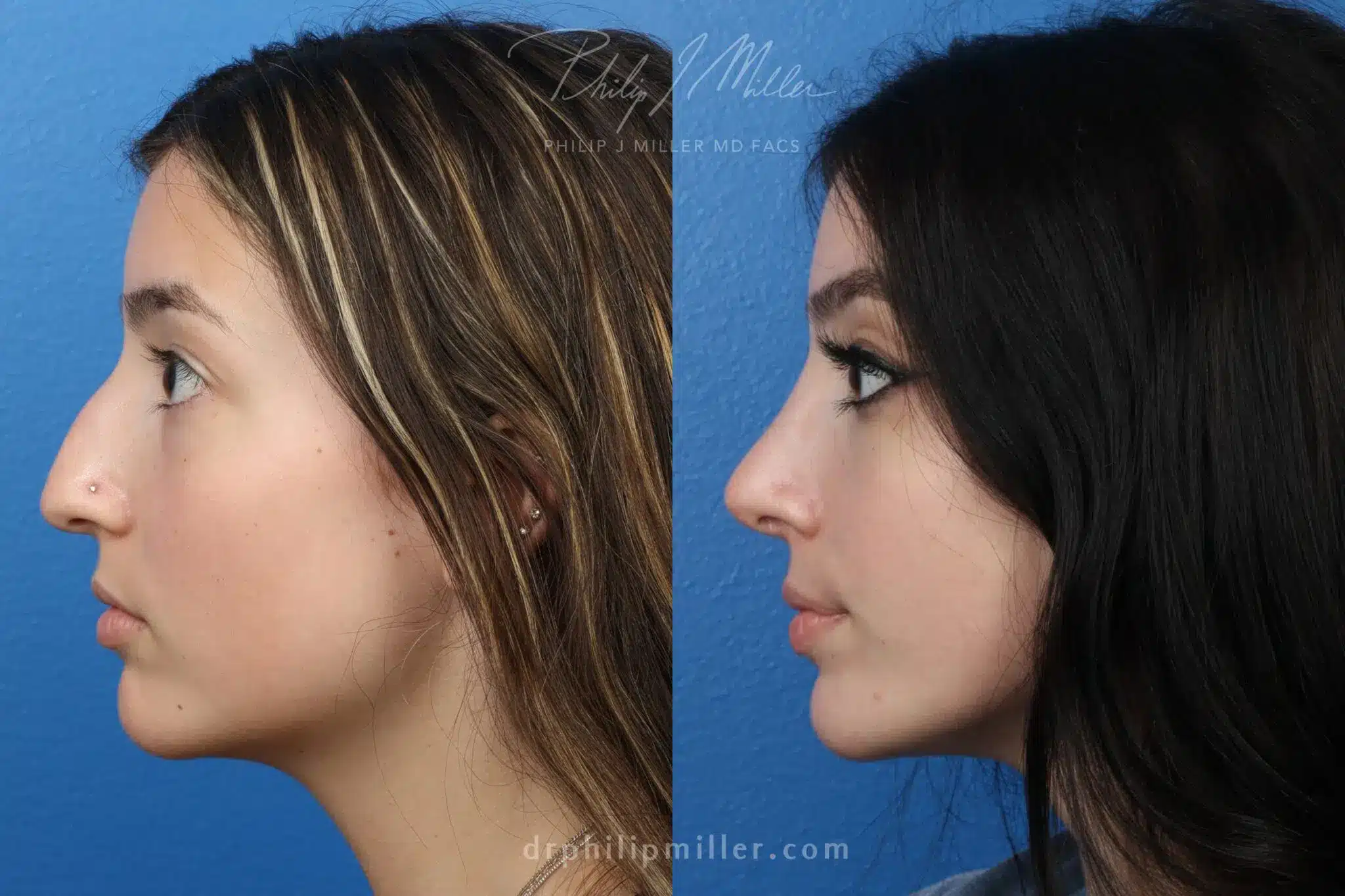
Months 2-3: As your nose continues to heal and swelling subsides even more, you will begin to see your full results and feel ready to show off your new nose. Keep in mind that it can take a year for all of the swelling to go down, however. During this time, your bone structure is more stable, enabling you to wear glasses and resume weight-bearing exercises.
Months 3-6: Any numbness or prickling sensations on the skin or inside your nose should begin to resolve at this point of the recovery process.
Months 6-12: Within a year, you will see the final results of your rhinoplasty procedure. With only minimal to no swelling, changes in the nose during this time will be subtle. The repositioned cartilage will have fully conformed to its new shape and the nasal tip should appear more refined.
There are factors that may impact your recovery timeline. These include skin texture and thickness, revision surgery, or extensive nasal reconstruction. During your consultation with Dr. Miller, he’ll be able to clearly discuss what recovery process to expect for your particular rhinoplasty procedure. He’ll also provide you with a set of post-operative care instructions, as well as recommendations for reducing swelling. Dr. Miller and his team will follow you through this entire process, but please be patient to see the final results.
Tips to Reduce Rhinoplasty Swelling
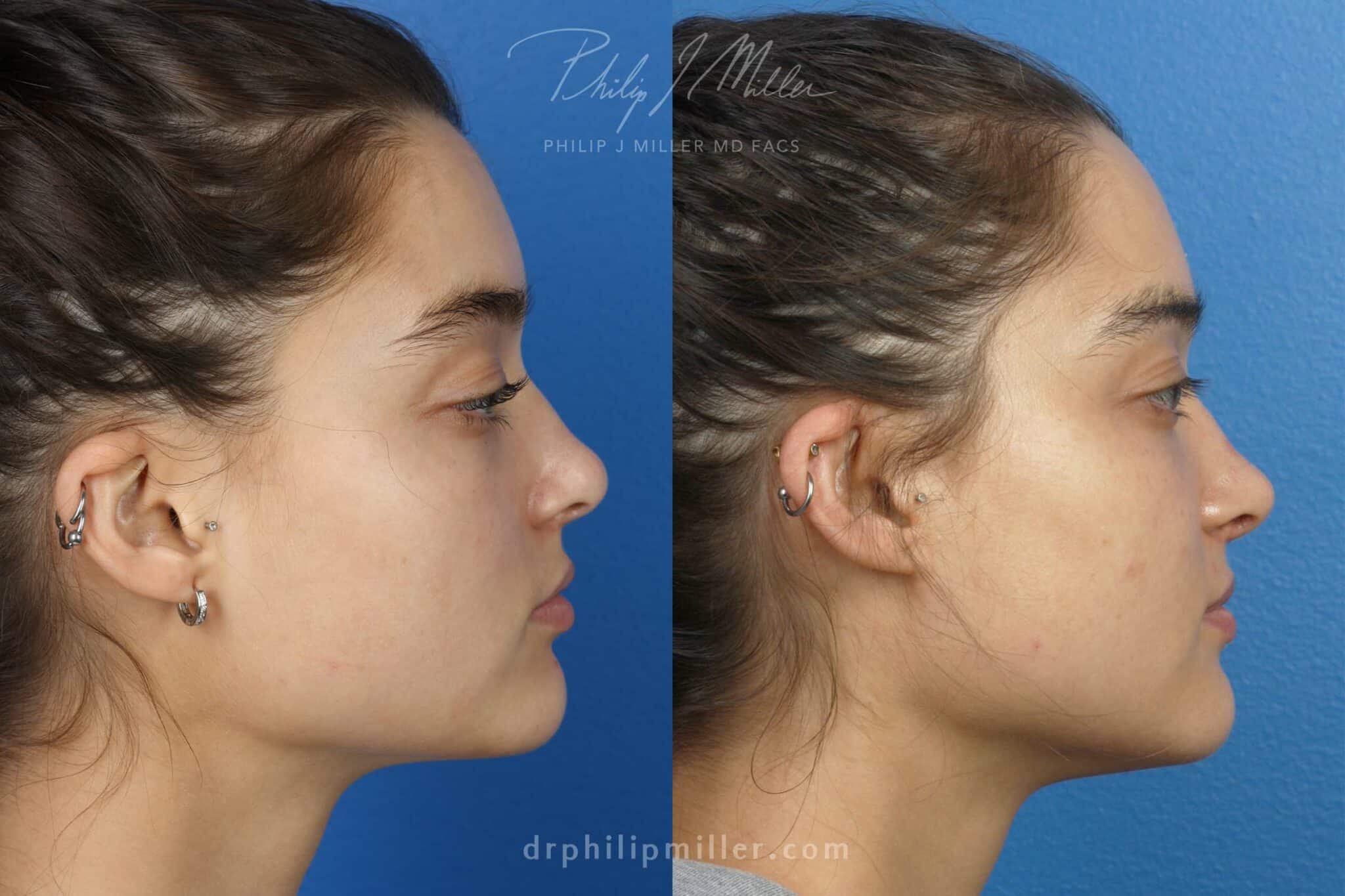
The best thing you can do as a patient is to follow all the after-care instructions provided by your surgeon. This ensures a smooth recovery free of any complications. Here are some recommendations to help reduce post-operative swelling and speed up your healing process, enabling you to see your full results sooner.
- Avoid sleeping on your side or belly. Sleeping on your back in an elevated position (propped on several pillows) is the best sleeping position. This will minimize fluid buildup, congestion, and discomfort.
- Stay hydrated by drinking lots of fluids. This will help reduce swelling by preventing fluid retention.
- Avoid salty foods which will increase the amount of fluid in your body and in turn result in more swelling due to water retention.
- Eat healthy foods like fruits, vegetables, and proteins that will promote wound healing (e.g., berries, leafy greens, beans, nuts and seeds, and poultry).
- Help the swelling subside by using cool compresses and ice packs around your nose. Do not apply ice directly on the skin. Prevent ice burns by wrapping an ice bag with a towel before application.
- Avoid hot baths and showers while you are still wearing a cast. Steam can worsen swelling and may even cause your cast to fall off.
- Avoid strenuous activities for at least 3-6 weeks, as these can increase blood flow and swelling.
- Avoid smoking which slows down the healing process and increases the risk of post-surgery complications.
- Avoid taking blood-thinning medications that can affect bleeding and impair healing.
Choosing Your Rhinoplasty Surgeon in New York City
For something as invasive as plastic surgery, choose a surgeon who will not only achieve your desired results based on your unique needs and goals, but someone who can provide the support and care you need before, during, and after your procedure.
As a board-certified facial plastic surgeon, Dr. Miller specializes in cosmetic facial procedures that are designed to help patients achieve their aesthetic goals. Dr. Miller creates innovative and comprehensive procedure plans in order to provide natural-looking results and outcomes that are life-changing. Considered one of the country’s leading experts in rhinoplasty and facial rejuvenation, Dr. Miller and his highly acclaimed team are proud to offer patients the highest level of care and customized treatments in Manhattan, New York, and New Orleans, Louisiana.
Dr. Miller’s approach to rhinoplasty encompasses the NatraLook® process that optimizes the patient’s overall experience by ensuring their journey yields the most rewarding results. It is NatraLook’s goal to help patients feel empowered before and after their surgery. During your NatraLook consultation, Dr. Miller evaluates your nose and facial features while listening to your concerns and goals. This process expands the typical plastic surgery experience into a safe, collaborative environment where you can explore your Aesthetic Confidence®.
Contact Dr. Miller to schedule a consultation and learn how his artistic skill and experience can bring balance to your features and help you achieve the best version of yourself.
3 Types of Facelifts You Need to Know About
Gone are the days when you would undergo surgery in hopes of restoring your youth, only to find your face looking like “done” after your procedure. Thanks to advanced, state-of-the-art technology and techniques, today’s plastic surgery combines science and art to create a natural, youthful appearance in both men and women.
Philip J. Miller, MD, FACS, is a double board-certified facial plastic surgeon who is known for creating natural results through customized treatment plans. He performs facelifts for patients with all degrees of aging, from the earliest fine lines and wrinkles to significant sagging and volume loss. With three basic types of facelifts, Dr. Miller will utilize his proprietary NatraLook® process to ensure you achieve the Aesthetic Confidence® you deserve when you look your very best.
3 Types of Facelifts
As the name suggests, a facelift is a procedure designed to lift and smooth the face to create a more youthful appearance. Also known as a rhytidectomy, they are appropriate for men and women of all ages, since Dr. Miller will tailor your treatment to your precise concerns and goals. There are three basic types of facelifts Dr. Miller offers in his New York and New Orleans offices.
Deep Plane Facelift
A deep plane facelift is the top choice for patients with significant aging symptoms. Deep plane facelifts reposition the muscle and soft tissue layer, or SMAS, before tightening the skin. This technique provides a more natural result than facelifts past that focused solely on skin tightening.
Deep plane facelifts enhance both the jowls and neck areas, but also let go of the cheek ligaments and raise the cheek fat pads and muscles. During a deep plane facelift, the skin and the SMAS are lifted together, rather than separately, which also creates more natural-looking results.
A deep plane facelift involves incisions behind and around the ears and along the hairline at the temples. Through these incisions, Dr. Miller can access the areas necessary to produce the most dramatic improvement. Surgery is performed using general anesthesia and takes about four hours to complete. Recovery from a deep plane facelift is typically 10-14 days.
Mini Facelift
Known as the “S-lift”, “weekend facelift”, and the “lunchtime facelift,” mini facelifts are quickly becoming a popular option in surgical facelifts. Less dramatic than a deep plane facelift, a mini facelift offers you a refreshed look by suspending the SMAS facial muscle.
Especially useful for the cheek and jowl areas, a mini facelift requires smaller incisions and a shorter recovery for most patients. The procedure may be performed using local anesthesia or IV sedation, rather than general anesthesia.
This type of plastic surgery is good for people who want to correct sagging cheeks, skin laxity in the jawline, midface sagging, marionette lines, jowls, and double chins. The improvements are not as dramatic as a deep plane facelift and typically don’t last as long. However, a mini facelift is an excellent choice for patients with earlier signs of aging that would like to refresh their appearance.
Liquid (Nonsurgical) Facelift
Nonsurgical, liquid facelifts involve a combination of injectable neuromodulators and dermal fillers to produce comprehensive improvement without anesthesia, incisions, or downtime. Neuromodulators like Botox® Cosmetic and Dysport® relax facial muscles that cause wrinkles to form in the forehead and around the eyes. Hyaluronic acid dermal fillers like Juvéderm® or Restylane® restore lost volume in the midface and along the jawline, while smoothing away wrinkles around the nose and mouth.
Results from a liquid facelift can be seen almost immediately, although slight swelling around the injection areas may interfere with your final results for a day or two. A liquid facelift is an excellent option for patients experiencing the earliest signs of aging or those who are not good candidates for surgical procedures.
What is the best type of facelift?
The best facelift for you is the one that meets your specific needs and goals. Dr. Miller will work with you to understand your concerns and create a customized plan to produce an optimal outcome for you. He will also take into account your medical history and current conditions to ensure the procedure you choose will be both safe and effective.
What is the most natural-looking facelift?
The most natural-looking facelift will be the one that is performed by an experienced facial plastic surgeon. Dr. Miller has the experience and expertise to ensure your results look natural no matter what type of procedure you choose. You can rest assured you won’t come out of your surgery with the typical windblow look of facelifts past. Instead, you will simply look like a better, more youthful version of yourself.
What is the best facelift without surgery?
Although there are radiofrequency (RF) and ultrasound therapies that effectively tighten and smooth the skin, the liquid facelift offers the ability to restore volume while treating fine lines and wrinkles. With minimal downtime, this procedure offers a quick fix for early signs of aging. Keep in mind that liquid facelifts produce temporary results and procedures will need to be repeated every few months to maintain your refreshed appearance.
Which facelift lasts the longest?
The deep plane facelift lasts up to 10 years, making it the facelift that lasts the longest. A mini facelift usually lasts around 5-8 years, depending on how well you care for your skin. Liquid facelifts must be repeated every year to maintain the positive results.
At your initial consultation, Dr. Miller will discuss the different types of facelifts available and help you choose the best option for you based on your specific needs and goals.If you are interested in learning more about facelifts or would like to schedule an appointment, contact our office in Manhattan, New York or New Orleans, Louisiana today.
Facelift vs. Neck Lift
Looking your best usually starts with your face – It is the first thing people notice. A new aesthetic appearance can open doors for you, making you look and feel your very best. Though you may not have found the Fountain of Youth yet, even with the many moisturizers and creams available today, a facelift, neck lift, or combination of the two may be the solution you are looking for to get your youthful facial appearance back.
Philip Miller, M.D. is our double board-certified facial plastic surgeon with 20 years of experience delivering safe and effective facelifts and neck lifts. He creates customized treatment plans for each patient he sees. And his caring and supportive medical team are always available to answer questions and help you decide which procedure is the right one. Contact us in New York or New Orleans to learn more.
What is a Facelift?
Popular in New York and across the globe, a facelift is a plastic surgery procedure that repositions fallen tissue and excises loose, excess skin. Explicitly used for saggy skin, facial hollowing, and deep wrinkles, facelifts today are more natural-looking than the windblown results these surgeries used to offer.
Weakened muscle and tissue, combined with collagen depletion in the dermal structure, can cause the skin to sag over time. The tissue under the muscle, the superficial musculoaponeurotic system (SMAS), can be tightened and lifted. Loose skin can be placed back over the face with the excess skin removed, promoting a more aesthetically-pleasing appearance.
In addition, Dr. Miller can reposition and remove any displaced fat that migrated downward to create a more youthful facial contour. Finally, the facelift procedure reduces the sagging or skin folds on the cheeks and jawline and other shape changes in the face that happens with age. A classic facelift focuses on the lower portion of the face, from the cheekbones down, as well as the jowls and jawline.
Dr. Miller offers customized treatment plans in his Manhattan, New York, and New Orleans, Louisiana offices to improve and enhance the appearance of your face. His proprietary NatraLook® process enables you to work through potential obstacles as you explore your Aesthetic Confidence in an unintimidating, supportive environment.
What is Neck Lift?
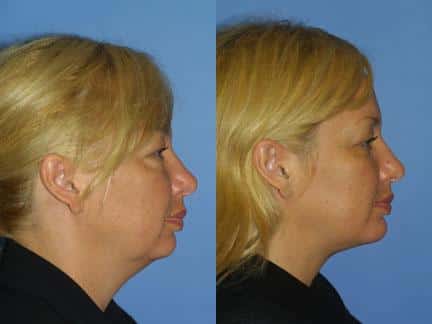
A neck lift is also known as a cervicoplasty, which targets loose, excess skin. It is often combined with a platysmaplasty that tightens the underlying neck muscle. A neck lift is a surgical procedure that removes extra skin and fat from the neck to reduce the visible signs of aging around the neck and jawline to create a smoother contour and more aesthetically pleasing profile. Dr. Miller may use a cervicoplasty, a platysmaplasty, or a combination, to rejuvenate, restore, and create a more refined appearance to the neck.
A neck lift is perfect for those who see most of their aging concerns settling beneath the jawline, such as horizontal banding, submental fat under the chin, and the dreaded “turkey neck.” Neck lift procedures take about two to three hours and can be done using local anesthesia or IV sedation for some patients. Results of a good neck lift can last many years if you give your skin TLC with daily sun protection and medical-grade skincare products that maintain skin health..
Are a facelift and neck lift the same?
A facelift and neck lift are two different procedures, although it may be necessary to perform a lower facelift to firm up the jawline with a neck lift to tighten the sagging skin under the chin. A facelift primarily focuses on loss of volume in the midface, jowl formation along the jawline, and creases around the nose and mouth. A neck lift targets loose skin below the jawline, submental fat under the chin, the formation of turkey neck, and horizontal banding that often occurs when the platysma muscle becomes overactive.
Dr. Miller will take the time to discover your specific concerns and goals to determine which procedure or combination of treatments might work best for you.
What’s the difference between a neck lift and a lower facelift?
Depending on the type of facelift performed, this procedure can refresh most of the face in a single procedure. A neck lift is focused solely on the neck, from the jawline to the decollete. Incisions for a facelift are usually placed around the ear and inside the hairline toward the temple. Incisions for a neck lift can also be placed around the ear, but extend across the lower scalp. Recovery from these procedures can be similar, taking about 1-2 weeks.
Can a neck lift be done without a facelift?
Occasionally, a patient can get a nice result from a neck lift alone. However, it is much more common to combine a neck lift with a facelift to ensure comprehensive improvement. A facelift is more likely to produce a satisfactory outcome when performed as a stand-alone treatment.
Does a facelift tighten the neck?
Although it primarily focuses on improving the cheeks and jawline, a facelift may tighten the neck by reducing skinfolds and sagging skin. However, for the best improvement in both areas, Dr. Miller will likely recommend performing a facelift and neck lift at the same time.
Skinfolds and sagging skin can make you feel unattractive and old. Getting a facelift, neck lift, or even both may help bring your youthful appearance back, giving you confidence and rejuvenation. Contact our Manhattan, New York, or New Orleans, Louisiana office today to make an appointment or ask questions about getting a facelift, neck lift, or both.
What are the best procedures for neck tightening in 2025?
With the abundance of neck tightening procedures available, choosing the most effective option can be a daunting task. From non-invasive techniques to minimally invasive surgeries, these varied procedures offer solutions for different skin types and aging concerns.
In this article, we explore the best neck tightening procedures available in 2025, focusing on their effectiveness, safety, and suitability to help you make a well-informed decision in your pursuit of a youthful and firm neckline.
Best Non-surgical Neck Tightening Procedures to Book in 2025
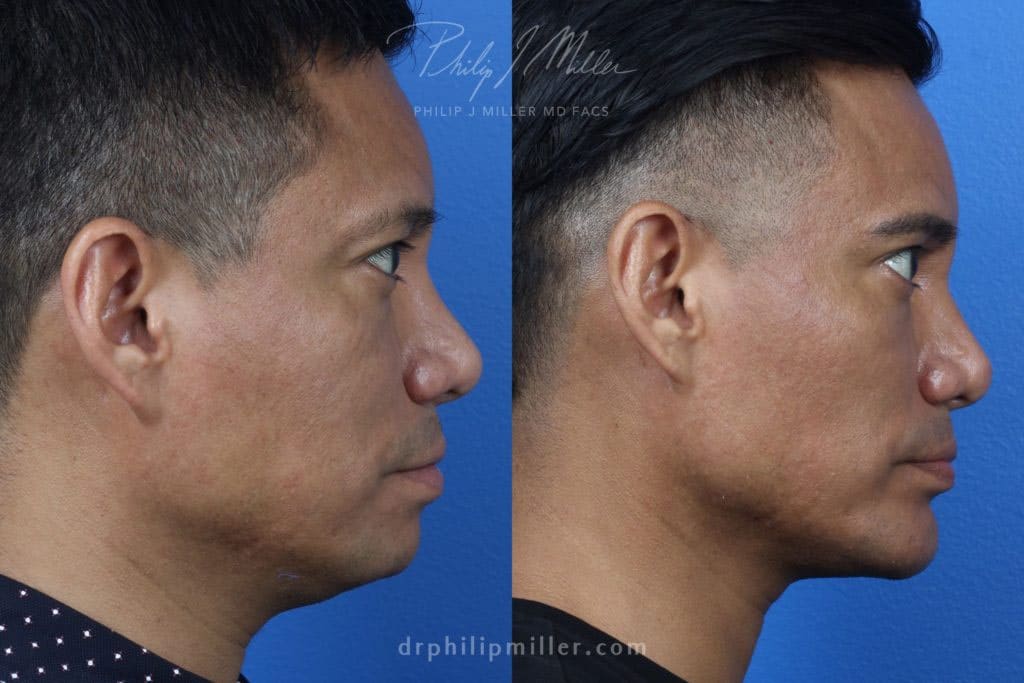
Non-surgical procedures are great options for patients seeking minimally-invasive treatments with maximum results. A non-surgical neck tightening procedure can be an especially effective option for patients with laxity and crepey skin texture.
Dr. Miller offers NeckTite™, a minimally-invasive procedure that uses patented radiofrequency assisted lipolysis technology to tighten the neck and jowls. NeckTite™ is completed with small cannulas for minimal scarring and downtime. It creates better results than liposuction and is an effective alternative to a surgical neck lift. The NeckTite™ device can contour the neck area for firmer, younger-looking skin and is ideal for patients with:
- Loose or sagging neck skin
- Jowls
- “Turkey neck”
Best Surgical Neck Tightening Procedures to Schedule in 2025
The neck is one of the first areas where signs of aging appear, and over time, wrinkles, lines, and skin texture will become more pronounced. It’s important to remember the neck area when you have facial rejuvenation procedures to make your appearance cohesive. A neck lift can remove excess fat and skin from the neck to create a smoother, more contoured look. It is a surgical procedure known as cervicoplasty (removes excess skin) or platysmaplasty (tightens loose neck muscles).
A cervicoplasty is the general name for a neck lift, while a platysmaplasty is part of the cervicoplasty. The cervicoplasty:
- Removes excess skin
- Makes an incision to reduce loose skin and contour the neck
The platysmaplasty:
- Tightens loose neck muscles
- Contours the neck
- Can be performed without a complete cervicoplasty
Dr. Miller performs neck lift surgeries in his Manhattan outpatient office, where he offers anesthesia or IV sedation to ensure a comfortable experience. The procedure takes 2-3 hours, and after surgery, patients see significant results and younger-looking skin. Patients looking for stunning results to turn back time can expect a neck lift to treat:
- Excess fat, jowls, or double chin
- Loose or sagging skin
- Wrinkles, lines, and creases
- Irregular contours
Adding Jaw Contouring
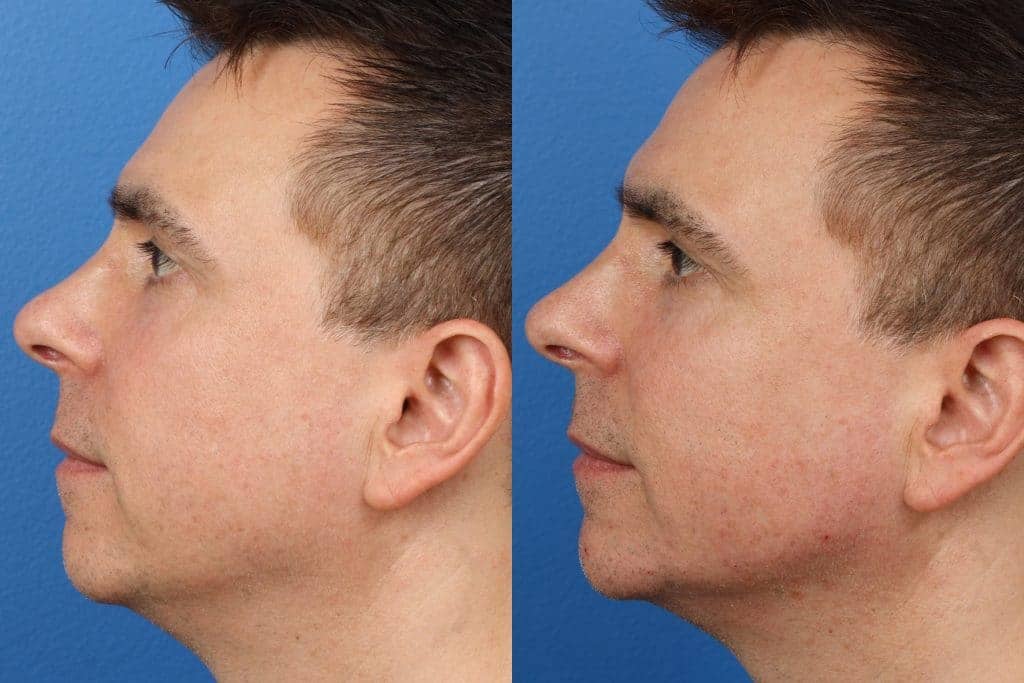
While healthy lifestyle choices such as diet, exercise, and a skincare regimen can help nurture healthy, toned skin, these habits are not effective in creating a strong facial profile. Dr. Miller’s proprietary procedure, G.I. Jawline, is a cosmetic procedure for men that creates a chiseled jawline. His proprietary procedure helps men get the classic look they desire with a sharp jawline, square chin, and a strong masculine facial contour. Dr. Miller from NYC focuses on enhancing existing features by outlining and highlighting the jawline structure.
The G.I. Jawline can include any one or combination of these treatments:
- Facial injectables: Injectables can target fine lines, wrinkles, and volume to create smooth skin, improve definition and enhance chin projection.
- Kybella®: This FDA-approved injectable treatment targets submental chin fat.
- Liposuction: This body-shaping procedure dissolves undesirable fat from hard to target areas, including submental fat under the chin.
- Neck-Tite™: This minimally-invasive procedure uses radiofrequency energy to melt fat and rejuvenate the neck and jowls.
- Medical grade implants: Implants are a permanent solution and are used to create facial balance and contour.
And The Best Procedure for Neck Tightening in 2025 Is…
…unique to you! Each patient has a unique look, facial structure, and cosmetic preference. Dr. Miller works closely with patients to identify their needs and the most effective solution to meet those needs. He customizes neck tightening treatments based on your goals to make the results stunning and natural.
Want beautiful, flawless results? The key is a personalized treatment plan with a focus on natural beauty. Dr. Miller wants patients to feel empowered to explore their Aesthetic Confidence® with a supportive experience. He uses the NatraLook® process, which evaluates and expands the plastic surgery experience into a safe opportunity to discuss personal obstacles and improve confidence.
Schedule Your Neck Tightening Treatment in New York Today
Dr. Miller works closely with patients to create a unified vision and personalized treatment plan. His extensive experience, innovative approaches, and advanced technology allow him to achieve unparalleled, life-changing results.
Contact us to schedule a consultation and learn more about neck tightening procedures that are right for you.
Can Rhinoplasty Make Your Nose Smaller?
As the center point of your face, your nose plays a significant role in creating your facial symmetry.
If you’re unhappy with your nose’s size, width, profile, or nostril size, nose surgery can help bring it into harmony with your other facial features. Rhinoplasty can change the shape and size of the nose to achieve your aesthetic goals.
For optimal results, it’s essential to consult with a board-certified plastic surgeon who specializes in rhinoplasty procedures. Reduction rhinoplasty, or nose reduction, is one of the most common procedures performed by top New York City facial plastic surgeon, Dr. Philip J. Miller. As a double board-certified facial plastic surgeon, Dr. Miller has the expertise, skill, and technique to create the best possible result for you.
How to Make Your Nose Smaller with a Surgical Nose Job
Augment the Nasal Tip
Sometimes a nasal tip adjustment is all that is needed to make the nose appear more proportionate. For instance, a large nasal tip can cause your nose to look more prominent. Dr. Miller will use specialized methods to alter the cartilage, improving your nasal tip’s projection, shape, or rotation.
Reduce the Bridge of the Nose
In other cases, the nasal bridge is the cause of a disproportionate appearance. If the bridge of your nose is out of proportion to the rest of your facial features, Dr. Miller can reduce the nasal bridge to bring it into balance.
Adjust the Size of Your Nostrils
The ideal nose is triangular, with proportionately-sized, symmetrical nostrils. When the nostrils are too large or wide, they draw attention away from your other facial features. In these cases, your appearance can be dramatically altered simply by manipulating the appearance and shape of the nostrils.
During a nostril reduction, Dr. Miller excises portions of the surrounding tissue via incisions below or inside the nose to reduce nostril size. As a result, scarring is minimal to non-existent.
A Rhinoplasty Procedure at Our Plastic Surgery Clinic
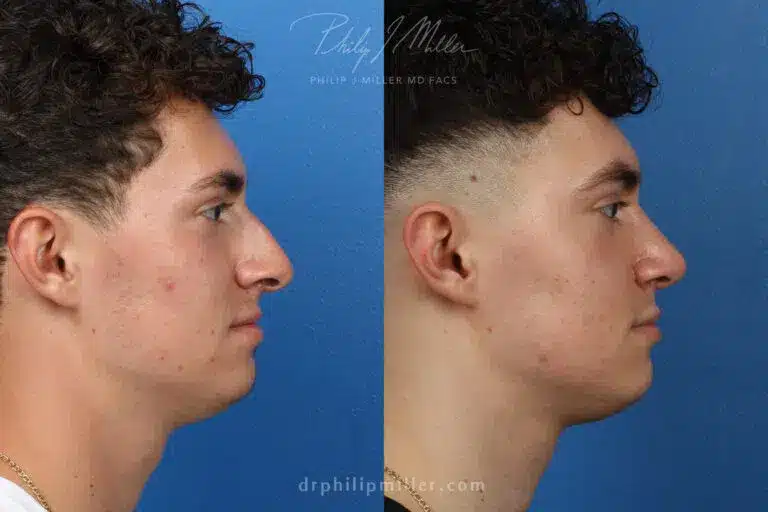
Before any nose surgery, you’ll consult with Dr. Miller at his New York City, NY plastic surgery clinic. He’ll assess the size, structure, and general condition of your nose and discuss your specific concerns and aesthetic goals.
Are you a candidate for a rhinoplasty?
For any elective surgery, good candidates should be healthy and have realistic expectations for improvement.
Nose surgery can be performed when the face and nose have reached full development—around age 16 for females and 17 for males. Rhinoplasty is not recommended for patients younger than this, as the nose can continue to change until this age.
Older people can benefit from rhinoplasty as well. As we age, our nose may begin to look longer, and the tip of the nose may start to droop. A nose job can correct these age-related changes for a more youthful appearance. In fact, it’s common to combine rhinoplasty with a facelift, eyelid surgery, or other anti-aging procedures.
Additional Benefits of Rhinoplasty
In addition to creating dramatic improvements in your appearance and self-confidence, rhinoplasty can correct functional issues of the nose you may not even know you have.
Some people have nasal passages that are too narrow for air to pass through freely. Treating this issue may involve removing tissue to open more space and facilitate easier breathing.
A deviated septum is another common functional problem, which can occur because of injury or accident. It’s also possible that the septum simply grew in a crooked manner. Since a deviated septum usually produces no external visual signs, most people are unaware they have this condition. For others, the deviation causes snoring, sinusitis, breathing difficulties, sleep apnea, and respiratory complaints. Visit mayoclinic.org to learn more about deviated septum symptoms and causes.

When you decide to have rhinoplasty surgery, this is also the time to address any breathing problems you may have noticed. Before performing your nose surgery, Dr. Miller will examine the nose to identify any functional issues. He will then create a surgical plan that addresses both the appearance and function of the nose.
Non-Surgical Alternatives
DIY Home Remedies
A search of the internet reveals a few methods for “DIY” nose jobs.
For instance, certain websites proclaim that nose exercises are an easy way to reshape the nose. Other suggested remedies involve applying toothpaste, apple cider vinegar, ginger, or garlic to reduce a large nose.
The shape of your nose where it attaches to your face is determined mainly by bone shape, and the tip of your nose is shaped primarily by cartilage. There’s no credible evidence to suggest that any DIY home remedy can influence the size or shape of the nose.
Unreliable advice abounds on the internet, and it’s always best to see a board-certified facial plastic surgeon for trustworthy recommendations based on expertise, not internet rumors.
Makeup
Makeup can’t change the size or shape of your nose, but it can help alter its appearance. Contouring is a popular way to create the illusion of a smaller, thinner, or reshaped nose:
- Using a bronzer two shades darker than your skin, outline both sides of your nose.
- Highlight the bridge of your nose with a matte highlighter.
- With a makeup sponge, manipulate the shadows and highlights to achieve the desired effect.
Many online tutorials demonstrate techniques for nose contouring depending on the effect you want to achieve.
Injectable Options
If you’re dissatisfied with your nose because of hollows, depressions, or asymmetry that affect its overall appearance, you may want to consider non-surgical rhinoplasty.
A non-surgical nose job makes subtle changes to the shape of the nose using injectable fillers, allowing surgeons to change the nasal tip’s shape, size, and position, straighten the nose, and even hide bumps. Non-surgical nose jobs are safe and effective, offering immediate results with exceptionally short recovery time.
These procedures do have limitations, however. The results aren’t permanent, typically lasting between 8-24 months. Non-surgical nose jobs can’t reduce the size of the nose and are best suited for making subtle changes.
Reduce the Size of Your Nose Permanently with Rhinoplasty in NYC
If you’ve been considering surgery to reduce the size of your nose, we invite you to schedule a consultation with Dr. Miller. He’ll help guide you through each step of your procedure from his state-of-the-art Manhattan plastic surgery clinic and surgical suite—one of the premier centers in New York City.